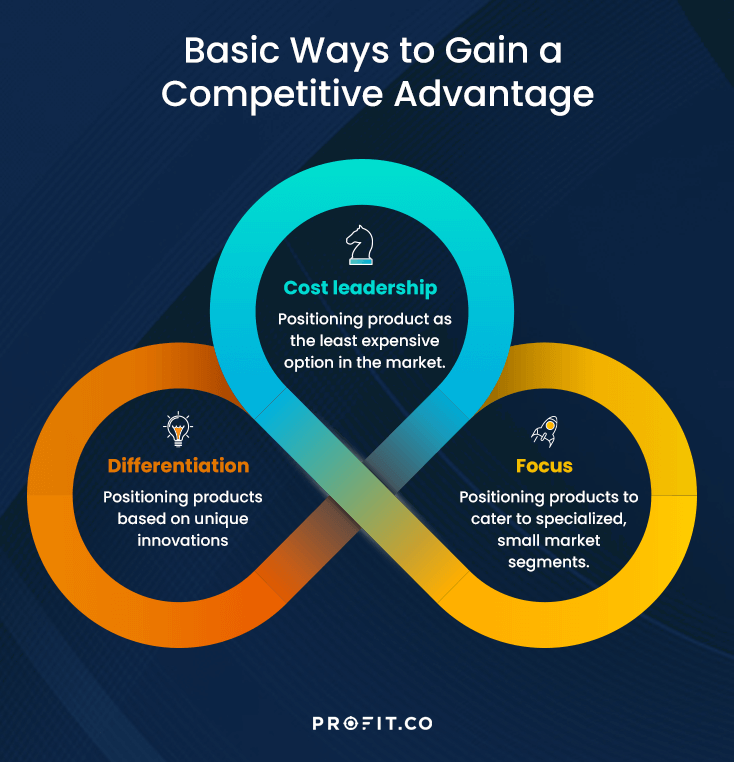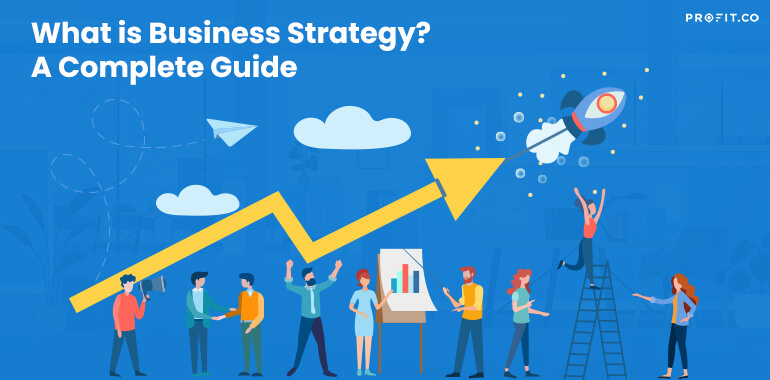The easiest part of any business is envisioning something ambitious; the most difficult part of it is finding ways to realize that vision. There is a clear necessity to lay out guidelines, action plans and a roadmap on how an organization will achieve its objectives and vision. This is where business strategy comes in.
This guide gives an overview of the importance of developing and successfully implementing a business strategy.
1. What is a business strategy?
2. 7 reasons why business strategy is important?
3. How to write a good business strategy?
4. What are the key elements of an effective business strategy?
5. Six key ingredients to successfully implement the business strategy?
What is a business strategy? Definition and Meaning.
Business strategy is the collection of all the decisions and actions taken to realize a broader vision. It governs all the business objectives, policies, processes and day-to-day activities of the organization. The business strategy lays the foundation for the organization to identify the priorities, create products, attain competitive advantage and increase sales. It is the one powerful tool that determines how the company competes in the market, what it offers and how it achieves the objectives and the vision of the organization.
7 reasons why business strategy is important?
Business strategy is crucial for any business to not only succeed in the foreseeable short-term but also sustain in the long term as well. Considering the competitive nature of the market today, it is virtually impossible to run a business without a sound business strategy. Along with the business strategy, it is vital to have an OKR strategy to make sure we implement the OKR framework to bridge the strategy execution gap. OKRs are a goal management process used by tech giants like Google and Intel to power their productivity. Business strategies are critical for any business because they:
1. Gives you a background knowledge of the business
It is easy to get lost when you start a business; without a direction and a starting point, it is really difficult to take your business forward. So, the first thing when you start a business is to clarify your vision, set your top-level objectives, create a plan of action and a roadmap as to how you will achieve those objectives. A lot of planning goes into all these, and they constitute the broader business strategy. When you have a strategy, you can quickly kickstart your business, align your employees and set them to follow the roadmap towards achieving your objectives.
2. Help you understand your own capabilities and possibilities
SWOT analysis is an indispensable component of a business strategy. Before laying out your plan of action, SWOT analysis gives you the opportunity to understand what are your strengths, weaknesses, challenges and potential. This helps you take into account various factors such as your competition, market conditions, areas that require innovation, the value you can potentially create for your customers, etc., and understand what you can realistically achieve. As a result, you can make the right promises, set the right goals and deliver what you promise, which is key to success in any business.
3. Help you avoid any stumbling blocks
Business strategies are usually written after thorough consideration of various important factors. So, when you adhere to the strategy, there are usually no unpleasant surprises and stumbling blocks in day to day activities, goal-setting, budgeting, resource allocation, communication, or anything related to the smooth functioning of the business. Every individual and team is clear about what needs to be achieved and what outcomes they need to produce, without the necessity for managers to constantly guide and oversee them. This ensures efficiency and productivity.
4. Gain competitive advantage
Your business strategy is usually designed to build on your strengths, tackle challenges and competition, and seize the opportunities that are present in your area of focus. As a result, a well planned strategy helps you innovate, address the pain points of customers, offer unique value and gain a competitive advantage.
5. Control every aspect of your business
Business strategies govern the functioning of the entire organization; so, every process, activity and task is aligned to the business strategy. This enables you to constantly monitor and quickly identify anything that is not aligned with the business strategy, or anything that does not yield desired outcomes. It empowers the management to fine tune the processes, make changes and align the workforce from top to bottom quickly.
6. Produce results with the available resources
Most often, lack of results is linked to inefficient use of the resources rather than the lack of resources. Strategic planning enables you to take audit of the available resources and deploy them in the most efficient manner possible in order to produce results.
7. Align your workforce
Since the organizations are comprised of a vast number of individuals and teams with diverse roles and responsibilities, there is a need for a binding component that connects everyone towards a common purpose and builds synergy and cohesiveness across the organization. Since the business strategy acts as a single guiding document for all, every individual and team derives their vision, goals, targets and modus operandi from the business strategy. So, the business strategy holds the organization together as a single, holistic unit and makes it produce outcomes to fulfill the overall objectives. However aligning the teams across the organization using a goal setting and tracking platform like OKRs will help execute the business strategy efficiently. Organizations can align their okrs with metric driven key results to teams to ensure seamless execution.
Strategy is a commodity, execution is an art.
How to write a good business strategy?
Writing a business strategy involves the following 5 steps:
- Coming up with a vision
- Setting objectives
- Analyzing business and market conditions
- Laying out a plan to gain competitive advantage
- Building strategy framework
1. Coming up with a vision
Vision is the foremost component of a business strategy. Before even choosing your objectives, it is essential to come up with a vision. Only when you have a vision, you can conceive your aspirations, core values and the domain you are going to operate in. The vision statement acts as the base for everything that will follow in the business strategy.
The vision statement highlights the ambitions and aspirations of the organization, mentions the target audience you want to serve, and underlines the values you will adopt in every aspect of your work while catering to your target audience.
For example, the vision statement of an online skill development platform may look like this:
“To be the leading online skill development platform that creates new learning and livelihood opportunities for women across North America, through visually-rich course content.”
Here,
a) “To be the leading” talks about the ambition of the organization.
b) “Online skill development” mentions the purpose of the business and talks about the nature of the products and services offered.
c) “Women across North America” denote your target audience. This part of the vision statement segments and filters the target audience based on demographic and socio-economic factors. This is typical of a vision statement of a company that focuses on the B2C segment. In the B2B segment, these factors are replaced by industry, sector, business model, or the sales model of your customers.
d) “Through visually-rich course content” talks about how you will achieve your ambition. It mentions how you will differentiate your product from the competition’s offerings. It underlines your value proposition and how you can market your offerings.
So, the vision statement packs the complete basic foundation of a business strategy. Once you have a vision statement, you can proceed further with other aspects of your business strategy.
2. Setting financial objectives
Once you have a vision, you have to come up with top-level objectives. These objectives are usually fixed around sales targets and profitability. In the end, every business aims to increase its revenue and profits, and the top-level objectives in the broader business strategies are primarily designed to help organizations to become profitable and successful. When the OKR framework is used to implement the business strategy, setting your okrs specially focussing on financial goals will help in reaching them without any gap. These objectives are different from the overall objectives of the organizational strategy, which are part of the lower-level functional strategy and will be collectively achieved by the outcomes of the work done by every employee and team.
3. Analyzing business and market conditions
Before venturing into any business, you have to make a business case based on a detailed analysis of various internal and external factors that would potentially impact your business and your long-term success. A SWOT analysis is performed to identify the strengths that can give you the competitive edge, weaknesses that could make your business vulnerable, opportunities that are present for you to seize using your strengths, and threats that can affect your profitability. All these factors play a crucial role in determining how you will operate and compete in the market, address your weaknesses and keep those threats at bay, and how you will play to your strengths and achieve competitive advantage.

4. Lay out a plan to gain a competitive advantage
Once you have a clear idea about how to compete in the current market scenario, it is time to define how you can position your product in the market, set a healthy profit margin and increase sales. There are three basic ways to gain a competitive advantage. It is also possible to have a blend of features from those three ways.
a) Cost leadership
Cost leadership is all about positioning your product as the least expensive option in the market. When you opt for this type of business strategy, you have to cut costs at all levels, starting from the choice of raw materials to efficient production methods and processes, reduced marketing budgets, etc., in order to hit the desired price of the product. It also requires reducing costs by means of economies of scale, i.e. when you produce your products in great numbers, the cost per unit proportionally goes down, creating a cost benefit across the supply chain.
For instance, you can buy carbon composite bicycle frames from Chinese manufacturers for as low as 1/6th the price of a low-end carbon frame from a reputed bicycle brand. This is made possible by their cost leadership; they can afford to cut costs in labor and other areas such as wind tunnel testing, cost of materials, production processes, etc. Some of those brands produce frames in great numbers, as they do contract manufacturing for multiple brands. As a result, they can source the materials at a much cheaper cost. However, these frames are targeted towards the majority of amateur cyclists who want a cheap and lightweight carbon frame, rather than anyone who is serious about cycling.
b) Differentiation
When you incorporate innovations in your products and create unique value for your customers, your products stand out and command a premium. In a business strategy based on differentiation, you can position your products in the market as unique, premium offerings that appeal to the top-tier customers who can afford the higher costs in order to gain access to your innovations. When you ask for a premium, the majority of the people won’t be able to afford the product. So, you have to manufacture fewer units and make up for higher production costs by setting a high profit margin.
For instance, when the whole television market is crowded with cheap 4K TVs, a select few manufacturers focus only on well-engineered premium offerings, pushing the boundaries of technology and even offering 8K models at the top end. Those 8K TVs are at least 6-7 times more expensive than the best 4K TVs. This is possible for them because of their business strategy based on differentiation, backed with R&D might, brand value and market leadership.
c) Focus
Business strategies based on focus cater to specialized, small market segments. For instance, musical instruments from a big brand can be expensive. But small-time enthusiasts and artisans make low-cost alternatives of the same instruments. These products have a charm of their own and attract a group of musicians who prefer hand-made instruments. This type of business strategy is cost-focused.
In contrast, musicians who perform at the highest level get their instruments custom-made to their preferences from highly skilled, independent instrument makers who know how to create a specific tone and customize the look, feel and handling of the instrument. They charge a fee that no enthusiast or small-time musician can afford. This kind of business strategy is differentiation focused.
5. Building strategy framework
Creating a strategic framework involves cascading your business strategy to specific functional strategies at a lower level that govern various aspects of the business, such as sales and marketing, operations, finances, etc. A strategic framework follows the spirit of the broader business strategy and takes it across all areas of an organization’s operations. When implemented correctly, this strategic framework captures the essence of the business strategy and imbibes its core values and vision in lower level strategies. Many successful tech giants like Google and Intel have used the OKR framework to implement strategy.
For instance, if you promise to deliver an affordable product in your vision statement, it should filter that intent down to the product strategy, sales and marketing and pricing strategies in order to deliver a really affordable product in line with your vision. This is only possible if every department and its specific strategies align with the business strategy. A strategy framework helps your business achieve a perfect alignment of departments and their strategies throughout the organization.
What are the key elements of an effective business strategy?
The business strategy encompasses everything that it is based upon and everything that it aims to achieve. So, a business strategy usually includes the following:
1. Vision & mission statements
2. Top-level objectives
3. Executive summary
4. SWOT analysis
5. Competitor analysis
6. Industry analysis
7. Financial projections
8. Operations plan
9. Elevator pitch
6 key ingredients to successfully implement the business strategy?
In a world of fluctuating market conditions and geopolitical instabilities, business strategy plays an important role in sustaining a business successfully. The key to building a successful business strategy is planning and preparing for those eventualities, basing the business strategy strongly on facts, data and research, and keeping it flexible and adaptable. In order to successfully implement business strategies you need some key elements. They are:
1. Good leadership
Good leadership is indispensable for formulating and implementing a sound business strategy. The most important quality of good leadership is the ability to come up with an ambitious vision and a clear rationale for why the organization should have that vision.
2. Strong management
Implementing a business strategy requires a strong management team that has the ability to communicate the strategy, inspire the workforce and ‘sell’ the business strategy to the teams to create widespread acceptance. They play a key role in monitoring the performance of the strategy by constantly keeping an eye on key metrics and KPIs. They need to constantly review the strategy implementation, make course corrections dictated by the market conditions and external factors, and realign the workforce to the revisions.
3. Ample Resources
When you write a business strategy, you have a clear roadmap. Allocating adequate resources for all the activities in the roadmap is crucial for the successful implementation of the strategy. Resource allocation is about judiciously allocating resources for all the identified priorities.
4. Up-to-date business systems
When you have ambitious goals, you should also have the right tools and means to attain them. Having the right business systems that are most suited for your use case goes a long way in improving efficiency and adding value. For instance, having customer relationship management software helps you drastically improve customer relationships, lead generation, and sales conversion. Without such a system, an e-commerce business would lag behind the competition when it comes to providing a good overall customer experience. Having such a system can make the difference between long-term success and failure. So, it is important to assess your needs and invest in the most suitable business systems such as accounting software, ERP platform, CRM software, OKR software, etc.
5. Strategic marketing process
Regardless of how well you have optimized your processes and created great products in line with your strategy, the success of your product depends entirely upon how your products resonate with the customers. For that, you have to figure out your marketing strategy, which includes how you position your brand and products, your pricing strategy, how you promote your USPs and which channels you would use to connect with the customers.
6. Rich organization culture
Having a good organizational culture is extremely important for business strategy implementation. While the strategy dictates the objectives, action plan and roadmap to attain success, organizational culture plays a crucial role in dictating the values, attitudes and behaviors that employees need to uniformly adopt to attain collective success. Cracks in organizational culture can damage your outcomes and lead to failure of strategy. For instance, an automotive company that enjoys short-term success by manipulating emission tests and falsifying results suffers long-term damage when it moves away from the core values of integrity and environment-friendliness. While implementing okrs for the success of your business strategy its vital to have an objective to enhance the organizational culture.
To learn how you can track OKRs with the market’s most intuitive OKR software, schedule a free demo with the OKR experts at Profit.co today!
FAQs
1. What are the 4 types of business strategies?
Business strategy can be categorized into corporate strategy, competitive strategy, functional strategy, and operating strategy.
2. What does a business strategy involve?
Business strategy is the sum of all plans and actions involved in achieving the vision and objectives of the business.
3. What are the three basic business strategies?
The three basic business strategies are cost leadership, differentiation and focus.




